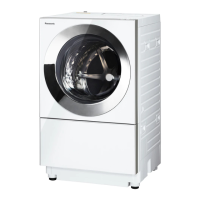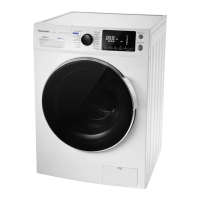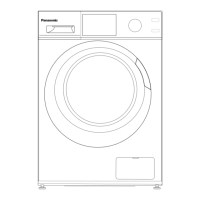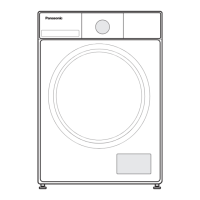36 37
When Necessary
Symptoms Tips for nice fi nish
Darkening or
yellowing of
clothes, colour
transfer or odour
Use correct amount of detergent. (P.21) (Using too small amount of detergent may
cause once-removed stains to stick to the clothes again, resulting in darkening of
clothes and odour.)
Use correct amount of softener. (P.21) (If excessive
softener is put in, the softener residue on clothes
may cause darkening of clothes.) When using in
combination with liquid detergent in particular,
darkening of clothes may be noticeable. In this case,
use powder detergent.
For clothes that easily lose colour (new coloured clothes or heavily soiled clothes),
wash separately. (P.13)
If yellowing of clothes is noticeable, the “Soak” program is recommended. (P.17, 26)
Yellowing of clothes may occur after drying, due to rust in water, detergent
residue, colour transfer, etc. (It may look charred.)
Discolouration caused by sunlight cannot be remedied.
If darkening of clothes, colour transfer or odour is noticeable...
→ Using the spoon that comes with the detergent, add 2 spoonfuls of
detergent to warm water of approx. 40 °C, soak clothes overnight
and wash.
→ If the stains still remain, soak them in solution with bleach
dissolved for 2 hours.
Use chlorine-based bleach for white clothes, and oxygen-based bleach for
coloured clothes.
(Follow each bleach instructions.)
Damaged clothes
Put delicates such as lingerie in laundry nets before washing. (P.13)
Chemical fi bres (jersey, fl eece, etc.) easily dry and they may be damaged due to
rubbing. Shorten the spin time.
Shrunk clothes
Depending on the material, weaving method, thickness and type, some clothes
are not suited for washing or drying.
• Check the care labels or material labels before washing
and drying.
Knit products or rough-woven materials may shrink by
drying even if they are cotton or linen fi bres.
Use sun drying in combination.
• Use Timer dry, take out the clothes in half-dry condition and dry on a laundry
pole immediately.
• Dry on a laundry pole and perform the “Dry” operation for finish.
Chemical fi bres may shrink due to heat generated in drying.
If cotton products have shrunk by drying
→Moisten clothes with water suffi ciently and stretch them. The shrunk clothes are
recovered to some extent.
If clothes washed with the “Hand Wash” program have shrunk
→(1) Spread the clothes to the desired size with marking
pins on an ironing board.
(2)
Hold the iron above the clothes and steam generously.
(3) Leave the clothes until they dry.
Detergent solution
For Better Results
Symptoms Tips for nice fi nish
Excessive
creases after
drying, or change
of texture
Depending on the material, weaving method, thickness and type, some clothes
are not suited for washing or drying.
→Check the care labels or material labels before washing and
drying.
(Thin and fl at-woven, or crape clothes tend to crease.)
Reduce the amount of laundry for better fi nish.
Take out the clothes immediately from the drum after drying.
Increasing the “Wash” time or the number of rinses tends to cause
the clothes to tangle and crease more. To prevent this, take out the
laundry once after spin, and detangle the clothes.
For cotton pants, large sheets, etc.
If they are not well-dried, after a 60-minute “Timer” dry, take out the laundry in half-
dry condition and hang outside.
Lint on clothes
Towels, etc. tend to produce lint. Separate wash is recommended.
If lint worries you, increase the number of rinses.
After drying operation in particular, lint tends to accumulate. Clean the appliance.
If lint is attached on clothes every time
→Wash the drum according to the following procedure and remove the lint in the
drum.
(1) Turn on the water faucet. (4) Select “Tub Clean”.
(2) Turn the power on. (5) Start.
(3) Select “Wash”.
• Approx. 11 hours will be taken. (If “Tub Clean” (30 °C) is used, approx. 6 hours
will be taken.) Clean the “Drain filter” after this operation. (P.30)
Persistent stains
Pre-treat stain or dirt containing mud which is diffi cult to remove. (P.12)
Stains are diffi cult to remove when left unattended.
Iron rust, mould, black writing fl uid, ink, lipstick, or stain caused by chemical
reaction such as permanent wave solution may not be removed.
According to how soiled the laundry is, use the “Cotton” program to make your
preferred settings. (P.26)
Rough
surfaces
Since drum type washers wash clothes while beating, fi bres of towels, etc.
may become fl at and you may feel rough on the surfaces.
If clothes stick to the drum and become rough on the surfaces, enable the sticking
prevention. (P.34)
Using softener will give nice fi nish.
If the results are still unsatisfactory, perform the “Dry” operation after washing, or
perform the “Timer” dry for 60 minutes after spin and dry on a laundry pole.
Materials of clothes, sewing conditions or type of detergents may be the causes of problems. Check those descriptions.
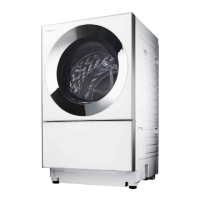
